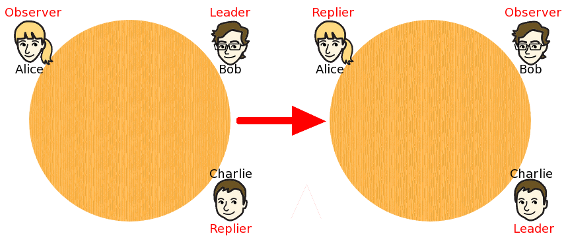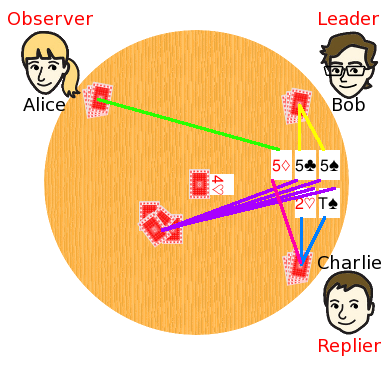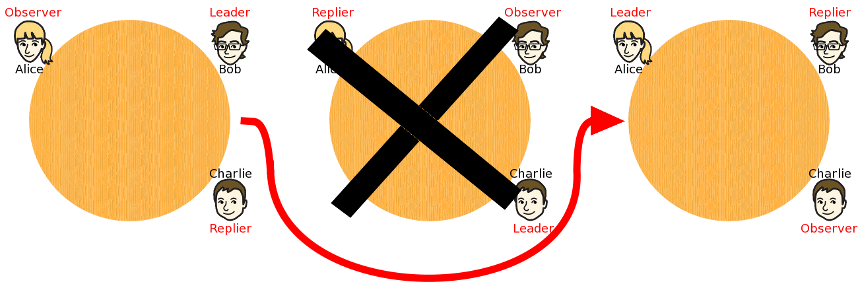Introduction
Bred Ryg (pronounced ‘Brel Roog’) is a seemingly little known cardgame from Denmark. ‘Bred Ryg’ means ‘Broad Back’, which may be an allusion to what is needed to endure losing.
During your first game, the strategy will be unclear and it will be frustrating. But as the game comes to an end then suddenly the whole point becomes clear and you will see what you should have been doing! Your second game will be a lot more fun!
The Players
The game works best with 3 players but it is also possible with more.
The Cards
A regular 52 card deck is used. Cards rank from high to low: A, K, Q, J, T, 9, … 2.
The Objective
This game has no winner, it only has a loser. During the game, players “top up” from the stock to ensure they always have at least 4 cards, but once the stock is exhausted and topping up is no longer possible, then the players race to discard their remaining cards. The loser is the player who still has cards when all other players have discarded theirs. Each game lost scores -1 (minus one) point.
The Deal
The players decide how long the match will be. If this will be a fixed number of games then it is best for the number of games to a multiple of the number of players.
For example, three players might agree to play a match consisting of as many games as they can play in one hour, or they might agree to play a match consisting of six games.
The players decide who will be Dealer in the first game. There is no significant advantage or disadvantage in being Dealer so no elaborate method is needed to decide who gets that role.
For example, it is often the person teaching the game who will be the Dealer in the first game.
Dealer deals four cards to each player, one at a time, and places the remaining cards face down in the middle of the table to form the stock.
The player on the left of Dealer lifts part of the stock, turns over the next card, places it face up under the remaining part of the stock such that it can be seen, and replaces the lifted cards. The suit of the exposed card determines the trump suit.
For example, if Alice, Bob and Charlie are playing, and Alice is the Dealer, then Bob cuts the stock and if he turns over the 4♡ then hearts are trumps.
After each game the role of Dealer is rotated clockwise around the table.
The Play
The roles of Leader, Replier and Observer are assigned clockwise around the table starting with the player to the left of Dealer. After each trick the roles will be rotated by one player clockwise, unless other rules dictate otherwise.
In practice, this just means that Replier will become Leader.
For example, if Alice, Bob and Charlie are playing and Alice dealt then, for the first trick, Bob is Leader, Charlie is Replier and Alice is Observer. For the second trick, Charlie is Leader, Alice is Replier and Bob is Observer. For the third trick, Alice is Leader, Bob is Replier and Charlie is Observer, and so on until the end of the game.

Leader plays a card, placing it face up between himself and Replier. Then Replier has two options: either to beat the card with one from his own hand and to throw both cards onto the waste pile, or to pick up Leader’s card and add it to his own hand. The rules of trick taking are: (a) if any trumps are played then the highest trump wins, otherwise it is the highest card of the suit led that wins, (b) Replier is not obliged to win a trick (unlike in many other trick-based games). There are no restrictions regarding when trumps may be played.
At the same time that Leader plays his first card to Replier, any player may play more cards to Replier provided they are all of the same rank as the first card played by Leader. The Replier must reply individually to each card that has been played! It is for this reason that, after the trick has been played, Observer may also need to top up.
For example, if Leader plays 5♠ (indicated by yellow line in the diagram below) then Leader might play also his 5♣ (yellow line) and Observer might play her 5♢ (green line). If Replier holds T♠, 2♡, 2♢, A♠ then he might beat Leader’s 5♠ with his T♠ (blue line), beat Leader’s 5♣ with his 2♡ (blue line), move all tricks won to the waste pile (indigo line) and pick up Observer’s 5♢ (violet line), which he is unable to beat.

If Leader plays more than one card of the same rank then he has special permission to lay a single additional card of any suit and rank. Only Leader may assert this privilige.
For example, if Leader plays 5♠ and 5♣ then he could also play his 7♣.
After the trick has been played then each player needs to “top up” from the stock so as to have at least four cards again. The order of topping up is important: the current Replier tops up first, then the current Leader and then the current Observer.
If the current Replier could beat all cards lead to him, then the roles are then rotated one position clockwise, otherwise the roles are rotated two positions clockwise.
In practice, this just means that Replier will become Leader unless he could not beat all cards led to him, in which case Observer becomes Leader.
For example, if Bob is Leader, Charlie is Replier and Alice is Observer and Charlie cannot beat the card that Bob led, then Alice will become Leader, Bob will become Replier and Charlie will become Observer.

There are a couple of other rules:
- Q♣ is special: the card may be led (by Leader, by Observer if Leader played a queen, or even by Replier if Leader played a queen, although this last case makes no sense at all) but it may not be played as part of Replier’s reply. What’s more, Replier may not beat it and therefore must pick it up. This rule applies to Q♣ regardless of what the trump suit is.
- The number of cards played to Replier may not exceed the number of cards that Replier has with which to reply.In practice, this is only an issue once the stock is exhausted and Replier has less than four cards before replying.
For example, if Leader has three cards, Replier has one and Observer has four, then Leader may play only one card and nobody may add any cards of the same rank.
Notes on strategy and etiquette
- Because of the rule mentioned above, Q♣ cannot be thrown onto the waste pile; monitor this because it is easy to reach the end of the game and discover nobody has her because she has accidentally been thrown out!
- If the role of Leader skips over you because you were forced to pick up at least one of the cards led to you, then the process of improving your hand by playing out bad cards and picking up hopefully better ones is slowed down and will result in you approaching the endgame (i.e. when the stock is exhausted and everybody has to play only with the cards that are then in circulation) with a worse hand than your opponents. If, at the endgame, your hand is worse that your opponents then there is an increased chance that the role of Leader will skip over you then, and so there is an increased chance that you will remain “stuck” in the game when your opponents have all played out their cards. Therefore: until the endgame and without spending high trumps, do your best to beat the cards led to you with the lowest cards possible. But, as I said above, during the first game the strategy will be unclear, or more accurately the reason why this strategy is good will be unclear, and as a consequence that first game can be a bit frustrating. But the second game … aaah! that will be great fun!
- Keeping Q♣ hidden in your hand until the endgame means that you are effectively playing most of the game with only 3 cards; therefore your hand will improve slower than everybody elses and you will probably enter the endgame with a worse hand than your opponents! If you get Q♣ then pass her ASAP!
- During the endgame it is possible to predict how the game will proceed even several tricks into the future, particularly if you remember which high trumps have not been thrown in the waste pile!
- In the endgame, if, as Leader, you play Q♣ then you may delay Replier’s exit from the game.
- When replying to multiple leads, reply to those you beat before those you must pick up (this way there is no danger of picking up a card and then using that same card to beat another one)
- Most often it is Leader who sees the opportunity to add additional cards to those being played to Replier, less commonly it is Observer and even less commonly it is Replier. Replier generally does it if he has two cards in his own hand one of which beats the other and the lower one is the same rank as the first card played to him by Leader: in this case he will discard three cards.
- When topping up, the exposed card, which is indicating the trump suit, may be picked up. If this is a high card and therefore a high trump then some forward-planning will be needed if you want to pick it up.
